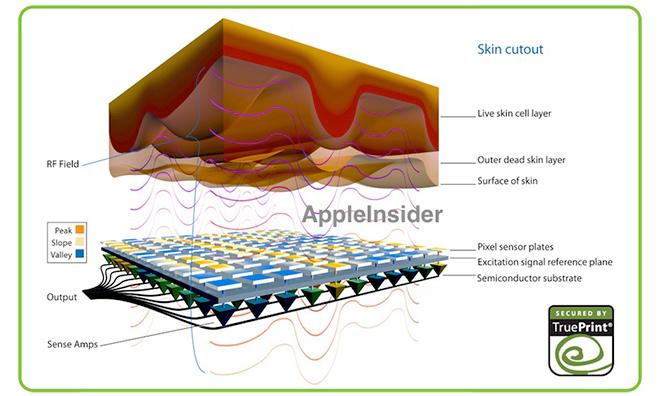When Apple launches its next-generation iPhone, the handset will likely carry a fingerprint sensor embedded into a slightly convex home button made out of sapphire, a major change to current designs.
By using a convex home button instead of the familiar concave design, Apple will be able to make room for the much rumored fingerprint sensor without losing precious internal space, according to well-informed KGI analyst Ming-Chi Kuo.
In a research note obtained by AppleInsider, Kuo says Apple is using sapphire because of its resilience to scratches, which will thus protect the fingerprint sensor embedded within.
AuthenTec, the biometric security firm Apple purchased in 2012, uses leading-edge capacitive and RF technologies in its biometric chips, a method that images fingerprints differently than existing optics-based systems. Kuo believes the tech is superior as the sensor is not subject to misreadings due to the build up of detritus or dust.
Further, the analyst sees Apple's current one-button iPhone design as being an optimal fit for a fingerprint reader. With a single home button, consumers are less likely to be confused as to where to place their finger for scanning.
While a convex home button design grants added space for a sensor, the part will become more susceptible to scratches than the concave component Apple has used since the first iPhone debuted in 2007. To protect the sensitive sensor, sapphire glass, a material with a hardness rating second only to diamond, will be used instead of the current plastic composite.
The convex design lends itself nicely to a patent Apple filed for in June describing a method of encapsulating a fingerprint sensor package within a confined space.
Kuo predicts the sensor's inclusion will keep the iPhone well ahead of competing Android and Windows Phone handsets, possible presaging Apple's entry into secure mobile payments. The system could also yield a safer way to access Apple's cloud computing services like iCloud and iTunes.
Earlier on Saturday, a report from AllThingsD cited inside sources as saying the Cupertino, Calif., company will unveil the next-generation iPhone at a Sept. 10 media event.
 Mikey Campbell
Mikey Campbell







-m.jpg)






 Charles Martin
Charles Martin
 Christine McKee
Christine McKee
 Wesley Hilliard
Wesley Hilliard
 Malcolm Owen
Malcolm Owen
 Andrew Orr
Andrew Orr
 William Gallagher
William Gallagher
 Sponsored Content
Sponsored Content







211 Comments
Anything's possible, I guess, but this rumor wouldn't seem to work well with current Authentec sensors.
A covering for capacitive or RF is usally only a few microns thick. Can sapphire slices be made that thin? Wouldn't carving out a convex version be extremely wasteful, too?
Not to mention that convex sounds like a terrible idea in one's pocket. A button sticking out is going to get clicked all the time. That was the whole idea behind the current concave design... to not easily be accidentally clicked.
Also, the home button isn't big enough for a whole-finger scanner, so you'd need to swipe, and a raised button sounds like it would easily get clicked.
I just don't see this whole idea of a scanner in the Home button anyway. Next to it would make more sense. Unless the whole idea is that waking up the phone by punching the Home button, fully authenticates the user for the entire time that the phone remains awake.
I don't think convex would work. Maybe a flat home button would.
Cue the finger-amputating thieves posts...
kdarling, "That was the whole idea behind the current concave design... to not easily be accidentally clicked." I have the feeling that if you accidently click the button that does not detect a fingerprint, it will do nothing.
In the light of the whole NSA Prism saga, does anyone now have concerns about a device that captures literally everything we say and everywhere we go and now with a fingerprint sensor to personally identify you? Just saying...